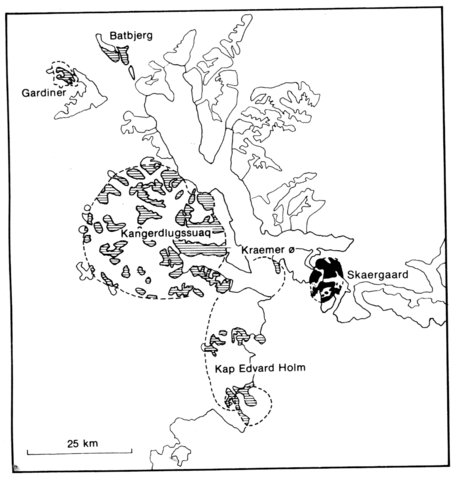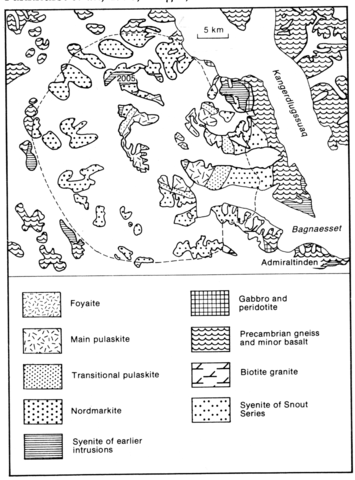stripes
Intruded into Precambrian gneisses on the southwest side of Kangerdlugssuaq Fjord, the Kangerdlugssuaq intrusion is a circular complex 33 km in diameter (Wager, 1965) with an outcrop area, including satellite intrusions, of 850 km2 (Brooks and Nielsen, 1982, Table 1), and is thus by far the largest intrusion of the Kangerdlugssuaq vicinity. Outer contacts are vertical or steeply outward dipping and numerous basalt xenoliths in the outer parts of the intrusion indicate it was originally overlain by basalt into which there was considerable stoping. The intrusion consists of a succession of four ring-like units which have a saucer-shaped form (Wager, 1965, Fig. 2) with gradational boundaries between them. The lower, outer ring is of quartz nordmarkite with quartz decreasing inwards to nordmarkite, then into quartz- and feldspathoid-free transitional pulaskite of the second ring. The third ring comprises pulaskite containing nepheline and sodalite and this passes finally into the central, and highest, unit which is a foyaite. The nordmarkite is estimated to constitute 90.6% by volume of the intrusion, the transitional pulaskite 3.5%, the pulaskite 5.3% and the foyaite 0.6% (Kempe et al., 1970, p. 14). The nordmarkites contain 0.2-14.1% quartz, with none at the inner boundary, perthite, a little sodic plagioclase, katophorite, some aegirine, minor biotite and accesories; basalt inclusions are fenitized. The transitional pulaskite consists of perthite, sodic plagioclase, as rims to the perthite, magnesio-arfvedsonite, aegirine, biotite and accessories. The main pulaskite again consists of perthite with sodic plagioclase rims, but often with a strongly developed parallel orientation, up to 11.6% nepheline and 3.8% sodalite; the ferromagnesian minerals remain magnesio-arfvedsonite, acmitic pyroxene and biotite as in the transitional pulaskite. The transition to foyaite is more abrupt than those earlier and marked by a rapid increase in nepheline and sodalite (up to 46%); amphibole is absent, the pyroxene changes to aegirine-augite and melanite appears in some rocks. Among the accessories lavenite, perovskite, chevkinite and astrophyllite are found in the lower units while hiortdahlite, analcime and rarely eudialyte occur in the foyaites. The variation in mineralogy through the series is illustrated graphically by Kempe et al. (1970, Fig. 5). Rock analyses are presented and discussed, including the problem of the transition from quartz-oversaturated to undersaturated rocks, by Kempe et al. (1970, p. 34). Data on a range of minerals are given by Kempe and Deer (1970) and on pyroxenes and amphiboles by Brooks and Gill (1982). The petrogenesis of the intrusion is considered by Kempe and Deer (1976) and, in the light of the evidence of oxygen and strontium isotopes, by Pankhurst et al. (1976). Intrusions peripheral to Kangerdlugssauq and considered to be co-magmatic have been described by Deer and Kempe (1976). They cluster close to the margin of the main intrusion apart from the Peak 2005 syenite which is emplaced within the nordmarkite of the Kangerdlugssauq intrusion. They comprise an earlier series of syenite and gabbro intrusions, including the Peak 2005, Kaerven, Augite and Bagnaesset syenites, the Kaerven and Admiraltinden gabbros and a peridotite, and the later Snout Series syenite and a biotite granite. The syenites and granite generally have the compositions of somewhat oversaturated nordmarkites and consist of perthite, quartz, aegirine, ferroaugite, magnesio-arfvedsonite, katophorite and accessories, including chevkinite.
BROOKS, C.K. and GILL, R.C.O. 1982. Compositional variation in the pyroxenes and amphiboles of the Kangerdlugssuaq intrusion, East Greenland: further evidence for the crustal contamination of syenite magma. Mineralogical Magazine, 45: 1-9.
BROOKS, C.K. and NIELSEN, F.D. 1982. The Phanerozoic development of the Kangerdlugssuaq area, East Greenland. Meddelelser om Gronland, Geoscience, 9: 1-30.
DEER, W.A. and KEMPE, D.R.C. 1976. Geological investigations in East Greenland. Part XI. The minor peripheral intrusions, Kangerdlugssuaq, East Greenland. Meddelelser om Gronland, 197(4): 1-25.
GLEADOW, A.J.W. and BROOKS, C.K. 1979. Fission track dating, thermal histories and tectonics of igneous intrusions in East Greenland. Contributions to Mineralogy and Petrology, 71: 45-60.
KEMPE, D.R.C. and DEER, W.A. 1970. Geological investigations in East Greenland. Part IX. The mineralogy of the Kangerdlugssuaq alkaline intrusion, East Greenland. Meddelelser om Gronland, 190(3): 1-95.
KEMPE, D.R.C. and DEER, W.A. 1976. The petrogenesis of the Kangerdlugssuaq alkaline intrusion, East Greenland. Lithos, 9: 111-23.
KEMPE, D.R.C., DEER, W.A. and WAGER, L.R. 1970. Geological investigations in East Greenland. Part VIII. The petrology of the Kangerdlugssuaq alkaline intrusion, East Greenland. Meddelelser om Gronland, 190(2): 1-49.
PANKHURST, R.J., BECKINSALE, R.D. and BROOKS, C.K. 1976. Strontium and oxygen isotope evidence relating to the petrogenesis of the Kangerdlugssuaq alkaline intrusion, East Greenland. Contributions to Mineralogy and Petrology, 54: 17-42.
WAGER, L.R. 1965. The form and internal structure of the alkaline Kangerdlugssuaq intrusion, East Greenland. Mineralogical Magazine, 34: 487-97.


